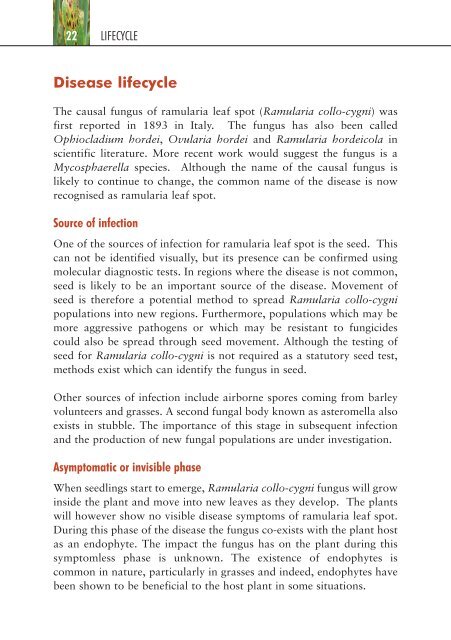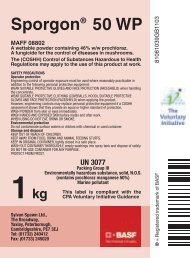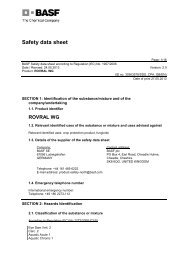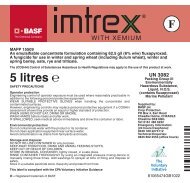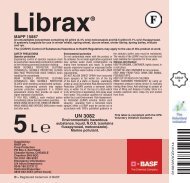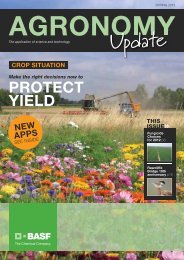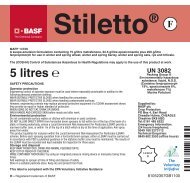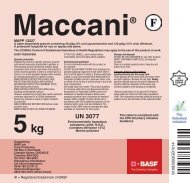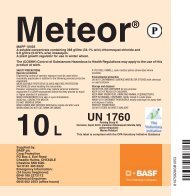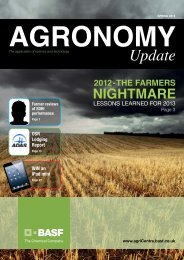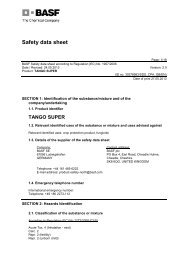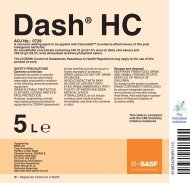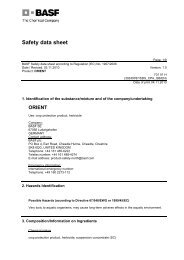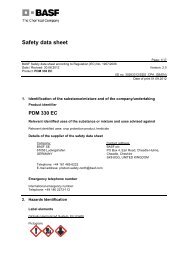a guide to the recognition and understanding of ramularia and other ...
a guide to the recognition and understanding of ramularia and other ...
a guide to the recognition and understanding of ramularia and other ...
Create successful ePaper yourself
Turn your PDF publications into a flip-book with our unique Google optimized e-Paper software.
22<br />
LIFECYCLE<br />
Disease lifecycle<br />
The causal fungus <strong>of</strong> <strong>ramularia</strong> leaf spot (Ramularia collo-cygni) was<br />
first reported in 1893 in Italy. The fungus has also been called<br />
Ophiocladium hordei, Ovularia hordei <strong>and</strong> Ramularia hordeicola in<br />
scientific literature. More recent work would suggest <strong>the</strong> fungus is a<br />
Mycosphaerella species. Although <strong>the</strong> name <strong>of</strong> <strong>the</strong> causal fungus is<br />
likely <strong>to</strong> continue <strong>to</strong> change, <strong>the</strong> common name <strong>of</strong> <strong>the</strong> disease is now<br />
recognised as <strong>ramularia</strong> leaf spot.<br />
Source <strong>of</strong> infection<br />
One <strong>of</strong> <strong>the</strong> sources <strong>of</strong> infection for <strong>ramularia</strong> leaf spot is <strong>the</strong> seed. This<br />
can not be identified visually, but its presence can be confirmed using<br />
molecular diagnostic tests. In regions where <strong>the</strong> disease is not common,<br />
seed is likely <strong>to</strong> be an important source <strong>of</strong> <strong>the</strong> disease. Movement <strong>of</strong><br />
seed is <strong>the</strong>refore a potential method <strong>to</strong> spread Ramularia collo-cygni<br />
populations in<strong>to</strong> new regions. Fur<strong>the</strong>rmore, populations which may be<br />
more aggressive pathogens or which may be resistant <strong>to</strong> fungicides<br />
could also be spread through seed movement. Although <strong>the</strong> testing <strong>of</strong><br />
seed for Ramularia collo-cygni is not required as a statu<strong>to</strong>ry seed test,<br />
methods exist which can identify <strong>the</strong> fungus in seed.<br />
O<strong>the</strong>r sources <strong>of</strong> infection include airborne spores coming from barley<br />
volunteers <strong>and</strong> grasses. A second fungal body known as asteromella also<br />
exists in stubble. The importance <strong>of</strong> this stage in subsequent infection<br />
<strong>and</strong> <strong>the</strong> production <strong>of</strong> new fungal populations are under investigation.<br />
Asymp<strong>to</strong>matic or invisible phase<br />
When seedlings start <strong>to</strong> emerge, Ramularia collo-cygni fungus will grow<br />
inside <strong>the</strong> plant <strong>and</strong> move in<strong>to</strong> new leaves as <strong>the</strong>y develop. The plants<br />
will however show no visible disease symp<strong>to</strong>ms <strong>of</strong> <strong>ramularia</strong> leaf spot.<br />
During this phase <strong>of</strong> <strong>the</strong> disease <strong>the</strong> fungus co-exists with <strong>the</strong> plant host<br />
as an endophyte. The impact <strong>the</strong> fungus has on <strong>the</strong> plant during this<br />
symp<strong>to</strong>mless phase is unknown. The existence <strong>of</strong> endophytes is<br />
common in nature, particularly in grasses <strong>and</strong> indeed, endophytes have<br />
been shown <strong>to</strong> be beneficial <strong>to</strong> <strong>the</strong> host plant in some situations.


